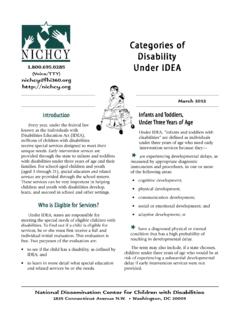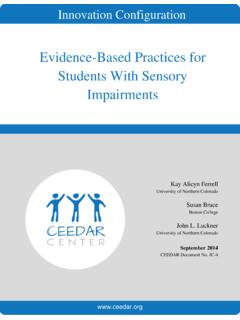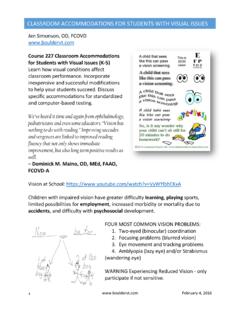Transcription of Visual Impairments, including Blindness
1 Disability Fact Sheet #13 (F S 13)sent by the weaker eye, resultingin permanent vision problems inthat took good care of hisglasses, but he didn t take well tothe patch, unfortunately. Heripped it off every time hisparents put it back back on again. So today hiseye still turns inward if he doesn twear his Impairmentsisual Impairmentsisual Impairmentsisual Impairmentsisual Impairmentsin Childrenin Childrenin Childrenin Childrenin ChildrenVision is one of our fivesenses. Being able to see gives ustremendous access to learningabout the world around us people s faces and the subtletiesof expression, what differentthings look like and how big theyare, and the physical environ-ments where we live and move, including approaching a child has a visualimpairment, it is cause forimmediate attention.
2 That sbecause so much learning typi-cally occurs visually. When visionloss goes undetected, children aredelayed in developing a widerange of skills. While they can dovirtually all the activities andtasks that sighted children takefor granted, children who arevisually impaired often need tolearn to do them in a differentway or using different tools Central to theirlearning will be touching, listen-ing, smelling, tasting, moving,and using whatever vision The assistance of parents,family members, friends,caregivers, and educators can beindispensable in that will be said about this in publication of NICHCYD isability Fact Sheet #13 November 2012 Julian s StoryJulian s StoryJulian s StoryJulian s StoryJulian s StoryWhen Julian was almost twoyears old.
3 He developed thisadorable habit of closing one eyewhen he looked at you. It almostseemed as if he were possibility that Julian had avisual impairment didn t initiallyoccur to his parents, but whenJulian s right eye started crossinginward toward his they went to the eyedoctor, who confirmed that, yes,Julian had a Visual impairment amblyopia, often called lazy eye. As the most common cause ofvision problems in children,amblyopia is the medical termused when vision in one eye isreduced because that eye and thebrain are not working Julian was also veryfarsighted, especially in the eyehe d taken to Julian had a brand-newpair of durable glasses suited tohis active two-year-old self.
4 Theeye doctor also put an eyepatchover Julian s better eye, so that hewould have to use the weaker eyeand strengthen its communica-tion with the brain. Otherwise,the eye doctor said, the brainwould begin to ignore the imagesVisual Impairments, including Blindness is theNational Dissemination Centerfor Children with Connecticut Avenue , DC (Voice / TTY) (Voice / of Vypes of Vypes of Vypes of Vypes of Visual Impairmentisual Impairmentisual Impairmentisual Impairmentisual ImpairmentNot all Visual impairments are the same, al-though the umbrella term Visual impairment maybe used to describe generally the consequence of aneye condition or eye has different parts that work together tocreate our ability to see.)
5 When a part of the eyedoesn t work right or communicate well with thebrain, vision is understand the particularvisual impairment a child has,it s helpful to understand theanatomy of the eye and thefunctions of its different than go into those detailshere, in this general fact sheet,we re pleased to refer you to theexperts for easy-to-understandexplanations and diagrams of the Visual system. National Eye Institute | Visit the Instituteonline for a diagram of the eye, what differentparts are called, and what aspect of vision eachpart is responsible of us are familiar with Visual impairmentssuch as near-sightedness and far-sightedness. Lessfamiliar Visual impairments include: strabismus, where the eyes look in differentdirections and do not focus simultaneously on asingle point; congenital cataracts, where the lens of the eye iscloudy; retinopathy of prematurity, which may occur inpremature babies when the light-sensitive retinahasn t developed sufficiently before birth; retinitis pigmentosa, a rare inherited disease thatslowly destroys the retina; coloboma, where a portion of the structure ofthe eye is missing; optic nerve hypoplasia, which is caused byunderdeveloped fibers in the optic nerve andwhich affects depth perception, sensitivity tolight, and acuity of vision.
6 And cortical Visual impairment (CVI), which iscaused by damage to the part of the brain relatedto vision, not to the eyes are also numerous other eye conditionsthat can cause Visual impairment . For a more com-prehensive glossary of conditions, here are tworesource pages you ll find helpful: American Foundation for the American Academy of there are many different causes of visualimpairment, the degree of impairment a child experi-ences can range from mild to severe (up to, andincluding, Blindness ). The degree of impairment willdepend on: the particular eye condition a child has; what aspect of the Visual system is affected ( ,ability to detect light, shape, or color; ability tosee things at a distance, up close, or peripherally);and how much correction is possible through glasses,contacts, medicine, or term Blindness does not necessarily meanthat a child cannot see anything at all.
7 A child who isconsidered legally blind may very well be able to seelight, shapes, colors, and objects (albeit indistinctly).Having such residual vision can be a valuable assetfor the child in learning, movement, and of a VSigns of a VSigns of a VSigns of a VSigns of a Visual Impairmentisual Impairmentisual Impairmentisual Impairmentisual ImpairmentIt s very important to diagnose and address visualimpairment in children as soon as possible. Somevision screening may occur at birth, especially if thebaby is born prematurely or there s a family historyof vision problems, but baby wellness visits as earlyas six months should also include basic visionscreening to ensure that a little one s eyes are devel-oping and functioning as might be : 2 Visual impairment , including Blindness (FS13)That said, common signs that a child may have avisual impairment include.
8 Eyes that don t move together when following anobject or a face Crossed eyes, eyes that turn out or in, eyes thatflutter from side to side or up and down, or eyesthat do not seem to focus Eyes that bulge, dance, or bounce in rapid rhyth-mic movements Pupils that are unequal in size or that appearwhite instead of black Repeated shutting or covering of one eye (asnoticed with Julian) Unusual degree of clumsiness, such as frequentbumping into things or knocking things over Frequent squinting, blinking, eye-rubbing, or facecrunching, especially when there s no bright lightpresent Sitting too close to the TV or holding toys andbooks too close to the face Avoiding tasks and activities that require goodvision4If any of these symptoms are present, parents willwant to have their child s eyes professionally exam-ined.
9 Early detection and treatment are very impor-tant to the child s CommonHow CommonHow CommonHow CommonHow Commonare Vare Vare Vare Vare Visual Impairments?isual Impairments?isual Impairments?isual Impairments?isual Impairments?Very common, especially as we grow older. Butthere are many causes of Visual impairments thathave nothing to do with the aging process, andchildren certainly can be and are affected. In , there are approximately: 490,420 children with vision difficulty (The term vision difficulty refers only to children whohave serious difficulty seeing even when wearingglasses and those who are blind.)5 42,000 children with a severe vision impairment (unable to see words and letters in ordinarynewsprint)6 59,341 children who are legally blind7 Each year States must reportto the Department ofEducation how manychildren with Visual impair-ments received specialeducation and relatedservices in our schoolsunder the Individuals withDisabilities Education Act(IDEA), the nation s specialeducation law.
10 Data reportedin 2011 (for the school year2010) indicate that the followingnumbers of children were served in the and itsoutlying areas: 3,447 children (ages 3-5) with visualimpairment8 25,670 children (ages 6-21) with visualimpairment9 Understanding HowUnderstanding HowUnderstanding HowUnderstanding HowUnderstanding HowChildren with VChildren with VChildren with VChildren with VChildren with Visual Impairments Learnisual Impairments Learnisual Impairments Learnisual Impairments Learnisual Impairments LearnChildren with Visual impairments can certainlylearn and do learn well, but they lack the easy accessto Visual learning that sighted children have. Theenormous amount of learning that takes place viavision must now be achieved using other senses are a primary information-gathering toolfor children with Visual impairments.











